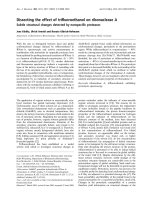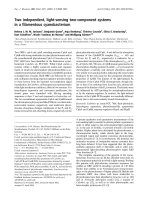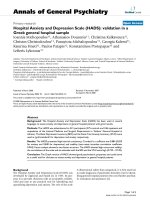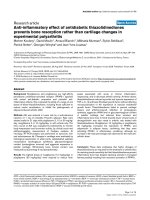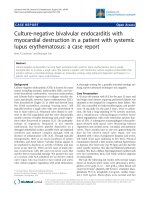Báo cáo y học: " Partial protective effect of CCR5-Delta 32 heterozygosity in a cohort of heterosexual Italian HIV-1 exposed uninfected individuals" pdf
Bạn đang xem bản rút gọn của tài liệu. Xem và tải ngay bản đầy đủ của tài liệu tại đây (218.73 KB, 4 trang )
BioMed Central
Page 1 of 4
(page number not for citation purposes)
AIDS Research and Therapy
Open Access
Short report
Partial protective effect of CCR5-Delta 32 heterozygosity in a cohort
of heterosexual Italian HIV-1 exposed uninfected individuals
Enrico M Trecarichi
1
, Mario Tumbarello*
1
, Katleen de Gaetano Donati
1
,
Enrica Tamburrini
1
, Roberto Cauda
1
, Christina Brahe
2
and
Francesco D Tiziano
2
Address:
1
Department of Infectious Diseases, Catholic University, Rome, Italy and
2
Department of Medical Genetics, Catholic University, Rome,
Italy
Email: Enrico M Trecarichi - ; Mario Tumbarello* - ; Katleen de
Gaetano Donati - ; Enrica Tamburrini - ; Roberto Cauda - ;
Christina Brahe - ; Francesco D Tiziano -
* Corresponding author
Abstract
Despite multiple sexual exposure to HIV-1 virus, some individuals remain HIV-1 seronegative
(exposed seronegative, ESN). The mechanisms underlying this resistance remain still unclear,
although a multifactorial pathogenesis can be hypothesised. Although several genetic factors have
been related to HIV-1 resistance, the homozigosity for a mutation in CCR5 gene (the 32 bp deletion,
i.e. CCR5-Delta32 allele) is presently considered the most relevant one. In the present study we
analysed the genotype at CCR5 locus of 30 Italian ESN individuals (case group) who referred
multiple unprotected heterosexual intercourse with HIV-1 seropositive partner(s), for at least two
years. One hundred and twenty HIV-1 infected patients and 120 individuals representative of the
general population were included as control groups. Twenty percent of ESN individuals had
heterozygous CCR5-Delta 32 genotype, compared to 7.5% of HIV-1 seropositive and 10% of
individuals from the general population, respectively. None of the analysed individuals had CCR5-
Delta 32 homozygous genotype. Sequence analysis of the entire open reading frame of CCR5 was
performed in all ESN subjects and no polymorphisms or mutations were identified. Moreover, we
determined the distribution of C77G variant in CD45 gene, which has been previously related to
HIV-1 infection susceptibility. The frequency of the C77G variant showed no significant difference
between ESN subjects and the two control groups.
In conclusion, our data show a significantly higher frequency of CCR5-Delta 32 heterozygous
genotype (p = 0.04) among the Italian heterosexual ESN individuals compared to HIV-1
seropositive patients, suggesting a partial protective role of CCR5-Delta 32 heterozygosity in this
cohort.
Findings
Despite multiple sexual exposures to HIV-1 virus, some
individuals remain HIV-1 seronegative (exposed seroneg-
ative, ESN). Although severe factors have been related to
HIV-1 infection resistance, the possible genetic mecha-
nisms underlying this resistance presently remain elusive
Published: 25 September 2006
AIDS Research and Therapy 2006, 3:22 doi:10.1186/1742-6405-3-22
Received: 15 June 2006
Accepted: 25 September 2006
This article is available from: />© 2006 Trecarichi et al; licensee BioMed Central Ltd.
This is an Open Access article distributed under the terms of the Creative Commons Attribution License ( />),
which permits unrestricted use, distribution, and reproduction in any medium, provided the original work is properly cited.
AIDS Research and Therapy 2006, 3:22 />Page 2 of 4
(page number not for citation purposes)
[1,2]. The most investigated genetic factor associated with
HIV-1 infection resistance is the homozygous presence of
a 32 bp deletion in CCR5 gene (CCR5-Delta 32) [3], i.e.
the main co-receptor used by the macrophage (M)-tropic
strain of the virus to infect peripheral blood mononuclear
cells. The 32 bp deletion leads to the synthesis of a trun-
cated protein which does not allow the proper interaction
between HIV-1 and the cell surface, thus preventing virion
endocytosis. Only 1% of Caucasian individuals is
homozygous for CCR5-Delta 32 allele and the frequency
of this genotype has been reported to be slightly higher in
anti HIV-1 seronegative individuals at high risk of HIV-1-
infection [4,5].
Other genetic factors have been reported to be involved in
HIV-1 infection susceptibility. It has been suggested that
the C77G variant in exon 4 of the CD45 gene (CD45-
C77G) is more frequent in HIV-1 infected subjects, com-
pared to uninfected individuals [6]. This transversion is
responsible for an abnormal splicing of exon 4, leading to
the production of a high molecular weight isoform of the
protein, normally expressed in the naive T cells but not in
the normal activated T cells [7]. Other mutations of this
gene have been associated to severe forms of combined
immunodeficiency in humans [7].
In the present study we investigated the possible role of
CCR5 and CD45 genic variants in the resistance to HIV-1
infection in a cohort of heterosexual Italian ESN individ-
uals.
The Catholic University hospital is a 1,700-bed tertiary
care centre with approximately 60,000 patient admissions
each year. Patients' provenience is mainly from central
and southern Italy, and to a lesser extent, northern Italy.
The hospital has a 60-bed unit for the admission of HIV
patients and a day-hospital for outpatient care.
The present study includes 30 healthy ESN individuals
(cases), partners of HIV-1 infected patients who were in a
regular follow-up in our outpatient unit. All ESN individ-
uals referred multiple unprotected heterosexual inter-
course for a period of at least two years with their own
partners. HIV-1 screening test was performed in these sub-
jects every six months. A randomly selected series of 120
HIV-1 infected patients in follow-up at our outpatient
unit and an equal number of individuals from the general
population, randomly selected among those who had a
genetic test done at the Institute of Medical Genetics of
our University, were included as control groups
(cases:controls = 1:4). All cases and controls, included in
the study upon informed consent, were of Italian origin,
thus sharing genetic background.
Genomic DNA was extracted from 5–10 ml of peripheral
blood, using salt extraction standard procedures. Hun-
dred ng of DNA were amplified by PCR in standard con-
ditions. For CCR5-Delta 32 allele, a primer pair including
the deletion was used (CCR5-D32-F:
5'CTTCATTACACCTGCAGCT3' and CCR5-D32-R:
5'TGAAGATAAGCCTCACAGCC3'); PCR fragments of
196 bp and 164 bp for wt and Delta 32 allele, respectively,
were separated on 2% agarose gel. For sequence analysis,
wt allele was amplified by two primer pairs (CCR5-F1:
5'ATGGAGGGCAACTAAATACATT3'; CCR5-R1:
5'AGATGACTATCTTTAATGTCTG3'; CCR5-F2:
5'CTCTCATTTTCCATACAGTCAGTATCA3'; CCR5-R2:
5'AAGCCATGTGCACAACTCTGACTG3') and sequenced
by using ABI-Prism 310 automatic sequencer (Applera),
according to the manufacturer's protocol. For the CD45-
C77G allele, a fragment including the mutation was
obtained by using primers CD45-F: 5'-GATTGACTACAG-
CAAAGATGCCC-3' and CD45-R: 5'-CCTCTGTGGTAT-
TAAAAGCACTAGCA-3'; subsequent HpaII digestion of
PCR products evidenced the mutated allele after agarose
gel electrophoresis. The presence of the C77G variant was
confirmed by sequence analysis of PCR products from
heterozygous subjects.
Contingency data were analysed by the two tailed χ
2
test
or Fisher's exact test, and continuous data were analysed
by use of the Student's t-test. Significance testing of differ-
ences in proportions was done using χ
2
test. Ninety-five
percent test-based confidence intervals (95% CI) were
used to determine the statistical significance of the odds
ratios (OR). Two tailed tests of significance at the p < 0.05
level were used to determine statistical significance. The
statistical analysis was performed using the software pro-
grams Intercooled Stata, version 8, for Windows (Stata
Corporation USA).
During the study, about 1700 HIV-1 positive patients
were in follow up in our outpatient unit. Thirty of them
had HIV-1 seronegative partners despite an history of reg-
ular unprotected heterosexual intercourse in the last 2
years.
Seven of 30 ESN subjects (23%) were males and 23
females (77%); the mean age (± SD) was 34 (± 5) years.
No statistical significant difference in sex and age distribu-
tion was observed between cases and controls.
Six of 30 (20%) ESN individuals were heterozygous for
the CCR5-Delta 32 allele compared to 9 of 120 (7.5%)
HIV-1 seropositive (p = 0.04) and 12 of 120 (10%) indi-
viduals from general population (p = 0.2). None of the
cases or of the controls had CCR5-Delta 32 homozygous
genotype (table 1).
AIDS Research and Therapy 2006, 3:22 />Page 3 of 4
(page number not for citation purposes)
The frequency of CCR5-Delta 32 allele was 10% in cases,
compared to 3.7% (p = 0.04) and 5% (p = 0.2) in HIV-1
seropositive controls and general population, respec-
tively. In all three groups the genotype frequencies
observed were in equilibrium, as predicted by the Hardy-
Weinberg equation.
Sequence analysis of the entire open reading frame was
performed in all ESN subjects, in order to investigate the
presence of further putative polymorphisms or mutations
in CCR5 gene coding region. The result of this analysis
indicated the absence of any variation.
CD45-C77G genotype analysis revealed that only one out
of 30 ESN individuals (3%) was heterozygous for this var-
iant. In both control groups, 3 out of 120 (7.5%) subjects
had heterozygous genotype (p = 0.8). None of the individ-
uals among cases or controls was homozygous for CD45-
C77G. The allelic frequencies of CD45-C77G were 1.7%
in ESN subjects and 1.3% in both control groups. None of
the individuals analysed had double heterozygous geno-
type at CCR5 and CD45 loci.
There was no significant difference in the frequency of
CD45-C77G polymorphism between ESN and the control
groups, suggesting that in our cohort this variant is not
involved in HIV-1 infection resistance or susceptibility.
No homozygous subject was found for CCR5-Delta 32
mutation in all three groups analysed, which is not sur-
prising considering the overall low frequency of this gen-
otype (table 1). The frequency of the CCR5-Delta 32
heterozygotes observed in our sample of the general pop-
ulation (10%) is very similar to the mean frequency
(9.1%) reported in other European studies [8,9]. In ESN
individuals we found a statistically significant higher fre-
quency of CCR5-Delta 32 heterozygous genotype (20%),
compared to the control group of HIV-1 seropositive indi-
viduals (7.5%).
It has been previously reported [3] that homozygous indi-
viduals for CCR5-Delta 32 are protected against HIV-1
infection. At the heterozygous state, this mutation has
been associated with a slower progression of the disease in
HIV-1 infected individuals [2]. However, whether this
mutation might have a protective role also in hetero-
zygous ESN individuals, presently remains controversial.
No significant difference in the distribution of CCR5-
Delta 32 heterozygous genotype between ESN and HIV-1
seropositive individuals has been previously reported in
four studies [10-13].
Interestingly, a partial protection against HIV-1 infection
has been observed in three different studies [14-16]. In
particular, Hoffman et al [14] described a significantly
higher frequency of CCR5-Delta 32 heterozygous geno-
type among the uninfected partners of heterosexual dis-
cordant couples, but not in homosexual couples. Similar
data were reported also by Philpott et al [15] in a large
cohort of women from different ethnic and racial back-
ground and with different transmission risk factors. In this
study [15] the presence of the Delta 32 allele was signifi-
cantly associated with lower rates of HIV-1 infection
among white individuals. Marmor et al [16], analyzing a
large sample of individuals, found a protective role of
CCR5-Delta 32 allele in uninfected subjects exposed to
HIV-1 infection risk through homosexual intercourse.
The discrepancy between these results may be partially
explained by the number of individuals included in the
different studies and/or by the relative impact of a single
genetic factor in the different populations analysed. Fur-
ther data supporting the hypothesis of a partial protective
effect of CCR5-Delta 32 heterozygous genotype have been
recently described [17]. In fact, Agrawal et al. [17]
reported that Delta 32 protein provides the down-regula-
tion of cell surface expression of the wild type CCR5 and
CXCR4 proteins through heterodimerization in CD4+ pri-
Table 1: CCR5 and CD45 genotypes in exposed uninfected subjects (ESN), HIV-1 seropositive patients and general population control
groups.
Genotype ESN (%) (n = 30) HIV-1 seropositive (%) (n = 120) P
c
General Population (%) (n = 120) P
d
CCR5
a
wt/wt 24 (80) 111 (92.5) 0.04 108 (90) ns
Δ32/wt 6 (20) 9 (7.5) 0.04 12 (10) ns
Δ32/Δ32 0 (0) 0 (0) ns 0 (0) ns
CD45
b
Wt/wt 29 (97) 117 (97.5) ns 117 (97.5) ns
C77G/wt 1 (3) 3 (2.5) ns 3 (2.5) ns
C77G/C77G 0 (0) 0 (0) ns 0 (0) ns
a
WT/WT, homozygous wild type CCR5 genotype; Delta32/Delta32 for homozygous mutant for 32-bp deletion in CCR5 gene and Delta32/wt for
heterozygous.
b
WT/WT, homozygous wild type CD45 genotype; C77G/C77G for homozygous mutant for the point mutation in exon 4 of CD45 gene and
C77G/wt for heterozygous.
c
P value calculated comparing ESN individuals vs HIV-1 seropositive control group; p = ns, non significant.
d
P value calculated comparing ESN individuals vs General Population control group; p = ns, non significant.
Publish with BioMed Central and every
scientist can read your work free of charge
"BioMed Central will be the most significant development for
disseminating the results of biomedical research in our lifetime."
Sir Paul Nurse, Cancer Research UK
Your research papers will be:
available free of charge to the entire biomedical community
peer reviewed and published immediately upon acceptance
cited in PubMed and archived on PubMed Central
yours — you keep the copyright
Submit your manuscript here:
/>BioMedcentral
AIDS Research and Therapy 2006, 3:22 />Page 4 of 4
(page number not for citation purposes)
mary cells infected by a recombinant Adenovirus carrying
Δ32 allele. However, additional studies are necessary to
better elucidate the role of CCR5 gene and of its variants
in HIV-1 infection resistance.
To the best of our knowledge, the present is the first study
investigating the allelic distribution of the genetic variants
CCR5-Delta 32 and CD45-C77G in a cohort of Italian het-
erosexually HIV-1 exposed and uninfected individuals.
Our data suggest a partial protective effect of CCR5-Delta
32 heterozygosis in the Italian ESN cohort population.
Competing interests
The author(s) declare that they have no competing inter-
ests.
Authors' contributions
EMT carried out the molecular genetic studies.
MT participated in the design of the study and performed
the statistical analysis.
ET and KDGD participated in the collection of the blood
samples and conception of the study.
RC and CB participated in its design and coordination and
helped to draft the manuscript.
FDT conceived of the study, and participated in its design
and coordination.
All authors read and approved the final manuscript.
References
1. O'Brien SJ, Nelson GW: Human genes that limit AIDS. Nat
Genet 2004, 36(6):565-74. Review
2. Hogan CM, Hammer SM: Host determinants in HIV infection
and disease. Part 2: genetic factors and implications for
antiretroviral therapeutics. Ann Intern Med 134(10):978-96.
2001 May 15. Review
3. Liu R, Paxton WA, Choe S, Ceradini D, Martin SR, Horuk R, MacDon-
ald ME, Stuhlmann H, Koup RA, Landau NR: Homozygous defect
in HIV-1 coreceptor accounts for resistance of some multi-
ply-exposed individuals to HIV-1 infection. Cell 86(3):367-77.
1996 Aug 9
4. Dean M, Carrington M, Winkler C, Huttley GA, Smith MW, Allikmets
R, Goedert JJ, Buchbinder SP, Vittinghoff E, Gomperts E, Donfield S,
Vlahov D, Kaslow R, Saah A, Rinaldo C, Detels R, O'Brien SJ:
Genetic restriction of HIV-1 infection and progression to
AIDS by a deletion allele of the CKR5 structural gene.
Hemophilia Growth and Development Study, Multicenter
AIDS Cohort Study, Multicenter Hemophilia Cohort Study,
San Francisco City Cohort, ALIVE Study. Science
273(5283):1856-62. 1996 Sep 27
5. Huang Y, Huang Y, Paxton WA, Wolinsky SM, Neumann AU, Zhang
L, He T, Kang S, Ceradini D, Jin Z, Yazdanbakhsh K, Kunstman K,
Erickson D, Dragon E, Landau NR, Phair J, Ho DD, Koup RA: The
role of a mutant CCR5 allele in HIV-1 transmission and dis-
ease progression. Nat Med 1996, 2(11):1240-3.
6. Tchilian EZ, Wallace DL, Dawes R, Imami N, Burton C, Gotch F, Bev-
erley PC: A point mutation in CD45 may be associated with
an increased risk of HIV-1 infection. AIDS. 15(14):1892-4.
2001 Sep 28. Erratum in: AIDS 2001 Nov 9;15(16):2210
7. Tchilian EZ, Wallace DL, Imami N, Liao HX, Burton C, Gotch F, Mar-
tinson J, Haynes BF, Beverley PC: The exon A (C77G) mutation
is a common cause of abnormal CD45 splicing in humans. J
Immunol 166(10):6144-8. 2001 May 15
8. Lucotte G, Mercier G: Distribution of the CCR5 gene 32-bp
deletion in Europe. J Acquir Immune Defic Syndr Hum Retrovirol
19(2):174-7. 1998 Oct 1
9. Zamarchi R, Indraccolo S, Minuzzo S, Coppola V, Gringeri A, Santa-
gostino E, Vicenzi E, De Silvestro G, Biagiotti R, Baldassarre C,
Chieco-Bianchi L, Amadori A: Frequency of a mutated CCR-5
allele (delta32) among Italian healthy donors and individuals
at risk of parenteral HIV infection.
AIDS Res Hum Retroviruses
15(4):337-44. 1999 Mar 1
10. Diaz FJ, Vega JA, Patino PJ, Bedoya G, Nagles J, Villegas C, Vesga R,
Rugeles MT: Frequency of CCR5 delta-32 mutation in human
immunodeficiency virus (HIV)-seropositive and HIV-
exposed seronegative individuals and in general population
of Medellin, Colombia. Mem Inst Oswaldo Cruz 2000,
95(2):237-42.
11. Lockett SF, Alonso A, Wyld R, Martin MP, Robertson JR, Gore SM,
Leen CL, Brettle RP, Yirrell DL, Carrington M, Brown AJ: Effect of
chemokine receptor mutations on heterosexual human
immunodeficiency virus transmission. J Infect Dis 1999,
180(3):614-21.
12. Liu H, Hwangbo Y, Holte S, Lee J, Wang C, Kaupp N, Zhu H, Celum
C, Corey L, McElrath MJ, Zhu T: Analysis of genetic polymor-
phisms in CCR5, CCR2, stromal cell-derived factor-1,
RANTES, and dendritic cell-specific intercellular adhesion
molecule-3-grabbing nonintegrin in seronegative individuals
repeatedly exposed to HIV-1. J Infect Dis 190(6):1055-8. 2004
Sep 15. Epub 2004 Aug 02
13. Rugeles MT, Solano F, Diaz FJ, Bedoya VI, Patino PJ: Molecular char-
acterization of the CCR 5 gene in seronegative individuals
exposed to human immunodeficiency virus (HIV). J Clin Virol
2002, 23(3):161-9.
14. Hoffman TL, MacGregor RR, Burger H, Mick R, Doms RW, Collman
RG: CCR5 genotypes in sexually active couples discordant for
human immunodeficiency virus type 1 infection status. J
Infect Dis 1997, 176(4):1093-6.
15. Philpott S, Weiser B, Tarwater P, Vermund SH, Kleeberger CA,
Gange SJ, Anastos K, Cohen M, Greenblatt RM, Kovacs A, Minkoff H,
Young MA, Miotti P, Dupuis M, Chen CH, Burger H: CC chemokine
receptor 5 genotype and susceptibility to transmission of
human immunodeficiency virus type 1 in women. J Infect Dis
187(4):569-75. 2003 Feb 15. Epub 2003 Jan 29
16. Marmor M, Sheppard HW, Donnell D, Bozeman S, Celum C, Buch-
binder S, Koblin B, Seage GR 3rd, HIV Network for Prevention Trials
Vaccine Preparedness Protocol Team: Homozygous and hetero-
zygous CCR5-Delta32 genotypes are associated with resist-
ance to HIV infection. J Acquir Immune Defic Syndr 27(5):472-81.
2001 Aug 15
17. Agrawal L, Lu X, Qingwen J, VanHorn-Ali Z, Nicolescu IV, McDer-
mott DH, Murphy PM, Alkhatib G: Role for CCR5Delta32 protein
in resistance to R5, R5X4, and X4 human immunodeficiency
virus type 1 in primary CD4+ cells. J Virol 2004, 78(5):2277-87.
